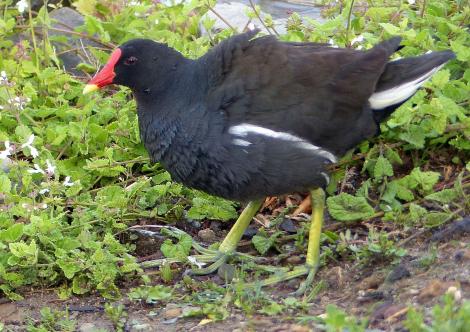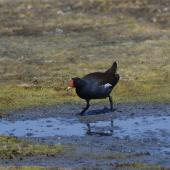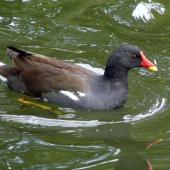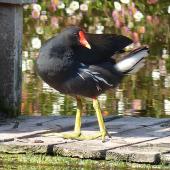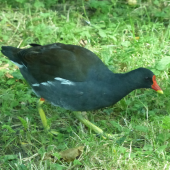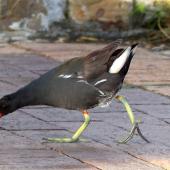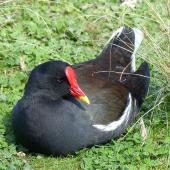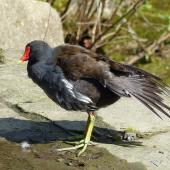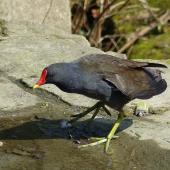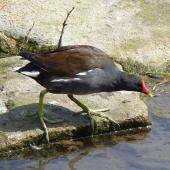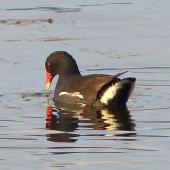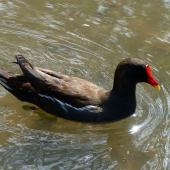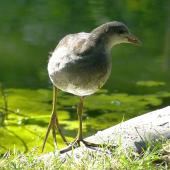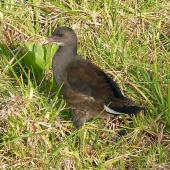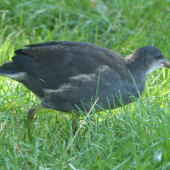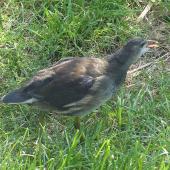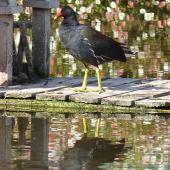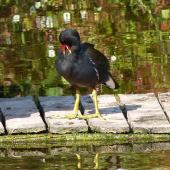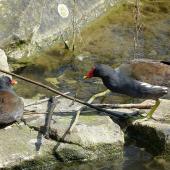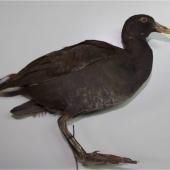Common moorhen
Gallinula chloropus Linnaeus, 1758
Order: Gruiformes
Family: Rallidae
Other names: common gallinule, common waterhen, moorhen
Geographical variation: About a dozen subspecies recognised. The closest in range to New Zealand is indica, which has a distribution from northern India to Japan and south to Indonesia, and is a seasonal migrant within this range.
The common moorhen is a medium-sized member of the rail family that has an almost worldwide distribution, but is replaced by the very similar dusky moorhen in Australia. Some populations are migratory, which may explain the single record in New Zealand – a specimen claimed to be from Otago, collected over 100 years ago. Like other gallinules, including the dusky moorhen, the common moorhen is most likely to be found in wetland habitats, particularly vegetated lake margins.
Identification
The common moorhen is a medium-large dark-plumaged rail with a white undertail, red bill with a yellow tip, a red frontal shield and yellow legs. A patch of white stripes on the flank, along with leg colour, separate the common moorhen from the otherwise similar dusky moorhen. Young birds are browner and lack the red shield.
Voice: a wide range of gargling calls and will emit loud hisses when threatened.
Similar species: rare vagrant dusky moorhen lacks the white streaks on the flank line and has greenish rather than yellow legs. Compare also with Australian coot is (black undertail, white bill and shield) and black-tailed native-hen (black undertail, green-and-orange bill).
Distribution and habitat
The common moorhen is abundant and very widespread in Europe, African and Asia. There are two records from Cocos (Keeling) Islands north-west of Australia, in November 2009 and 2015. The American forms, now referred to as common gallinule (G. galeata), are widespread in both North and South America. Common moorhens typically inhabit marsh environments and vegetated lakes.
New Zealand records
A single record. A specimen in the Canterbury Museum was purchased from A.C. O’Connor who had previously obtained it from the taxidermist W. Smith who worked in Dunedin from 1895-1910. There is some doubt as to whether the bird originated in New Zealand and no collector’s label was attached to the specimen. The specimen was identified by Dr Alexander Wetmore from the Smithsonian Institute as an immature G. chloropus indica with the frontal shield not fully developed.
Behaviour and ecology
Most common moorhen populations are sedentary, but northern populations exposed to severe winter conditions are migratory. They breed as territorial pairs during the spring, nesting in reedbeds on rivers and ponds. They are largely solitary throughout the year, but form feeding groups of up to 30 during the winter.
Food
Common moorhens are omnivorous, consuming a wide variety of plants and small water creatures.
Weblinks
http://www.avianweb.com/commonmoorhens.html
References
Chesser, R.T Banks, R.C.; Barker, F.K.; Cicero, C.; Dunn, J.L.; Kratter, A.W.; Lovette, I.J.; Rasmussen, P.C.; Remsen, J.V.; Rising, J.D.; Stotz, D.F.; Winker, K. 2011. Fifty-second supplement to the American Ornithologists' Union Check-List of North American Birds. Auk 128: 600-613.
Menkhorst, P.; Rogers, D.; Clarke, R.; Davies, J.; Marsack, P.; Franklin, K. 2017. The Australian bird guide. London, Christopher Helm.
Turbott,E.G.; Scarlett, R.J. 1964. Australian stragglers in New Zealand, with first record of the fan-tailed cuckoo. Notornis 11: 107-109.
Recommended citation
de Lisle, G.W. 2013 [updated 2017]. Common moorhen. In Miskelly, C.M. (ed.) New Zealand Birds Online. www.nzbirdsonline.org.nz
Common moorhen
- Breeding season
-
- Jul
- Aug
- Sep
- Oct
- Nov
- Dec
- Jan
- Feb
- Mar
- Apr
- May
- Jun
- Egg laying dates
-
- Jul
- Aug
- Sep
- Oct
- Nov
- Dec
- Jan
- Feb
- Mar
- Apr
- May
- Jun




